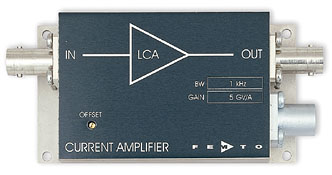Ultra Low Noise Current Amplifier, Preamplifier
- Ultra low noise – input noise down to .2 fA/
 Hz
Hz - Bandwidth up to 400 kHz
- Gain up to 1013 V/A
- Flat Frequency Response
- EMI-Shielded Case

Why use a Preamplifier Module?
Unlike desktop-amplifiers, preamplifier modules provide gain close to the detector before the signal-to-noise ratio significantly decreases due to cable capacitance and noise pickup. Signal processing and measuring after preamplifying has no effect on the signal/noise performance.
Gain and Noise
In order to achieve an extremely low noise performance in the LCA current amplifier very high gains were chosen, while nevertheless minimizing the associated bandwidth reduction. Thus, as a result of our sophisticated development efforts, we can offer a professional “High-End” current amplifier line. The noise performance of our products surpasses by far that of conventionally designed OpAmp-current-to-voltage converters at the corresponding bandwidth.
Bandwidth and Frequency Response
FEMTO ultra low-noise current amplifiers show almost ideal behavior without the need for special adaptations or frequency compensations. Bandwidth and frequency response are independent of source capacitance up to 10nF. No gain peaking will occur.
Preamplifier for Lock-Ins
Lock-in amplifiers usually have a special current input. By using instead a low noise preamplifier in noise limited experiments, even the sensitivity and speed of a DSP Lock-in is strongly increased. Femtoampere currents can then be measured within a few milliseconds.
Applications
Photodetection with PMTs and Photodiodes
Spectroscopy
Scanning Tunneling Electron Microscope
Ionization Detectors
Pyro and Pyroelectric Detectors
Variable Gain Current Amplifier Comparison
Ultra low noise amplifier selector:
| Model | 3-dB Bandwidth (DC ...) | Noise Current {/√Hz] | Transimpedance (Gain) [V/A] | Rise/Fall Time |
|---|---|---|---|---|
| DDPCA-300 | Variable - see DDPCA product page | |||
| DLPCA-200 | Variable - see DLPCA product page | |||
| LCA-2-10T | 2Hz | 0.2 fA | 1x1012 and 1 x 1013 switchable | 200ms |
| LCA-30-1T | 30 Hz | 0.5 fA | 1 x 1012 | 12 ms |
| LCA-30-200G | 30 Hz | 0.5 fA | 2 x 1011 | 12 ms |
| LCA-200-100G | 200 Hz | 1.5 fA | 1 x 1011 | 2 ms |
| LCA-200-10G | 200 Hz | 1.5 fA | 1 x 1010 | 2 ms |
| LCA-1K-5G | 1 kHz | 3 fA | 5 x 109 | 400 μs |
| LCA-2K-2G | 2 kHz | 4.5 fA | 2 x 109 | 200 μs |
| LCA-4K-1G | 4 kHz | 6.5 fA | 1 x 109 | 100 μs |
| LCA-10K-500M | 10 kHz | 10 fA | 5 x 108 | 40 μs |
| LCA-20K-200M | 20 kHz | 14 fA | 2 x 108 | 20 μs |
| LCA-40K-100M | 40 kHz | 19 fA | 1 x 108 | 10 μs |
| LCA-100K-50M | 100 kHz | 30 fA | 5 x 107 | 4 μs |
| LCA-200K-20M | 200 kHz | 40 fA | 2 x 107 | 2 μs |
| LCA-400K-10M | 400 kHz | 65 fA | 1 x 107 | 1 μs |
| NOTE: Bandwidth and frequency response are absolutely independent of Detector Capacitance. Guaranteed and 100 % tested up to 10 nF for each amplifier. | ||||
| Low Noise Input/Output Cable available: CAB-LN1 Low Noise Cable | ||||
| Output voltage ±10 V @ 10 kOhm load. Offset adjustable by trimpot or external control voltage. AC-Coupling optional. Output short-circuit protected. Power supply via 3-pin LEMO socket. A mating connector is provided with the device. Optional power supply PS-15 is available. For further information, please view datasheets. | ||||
